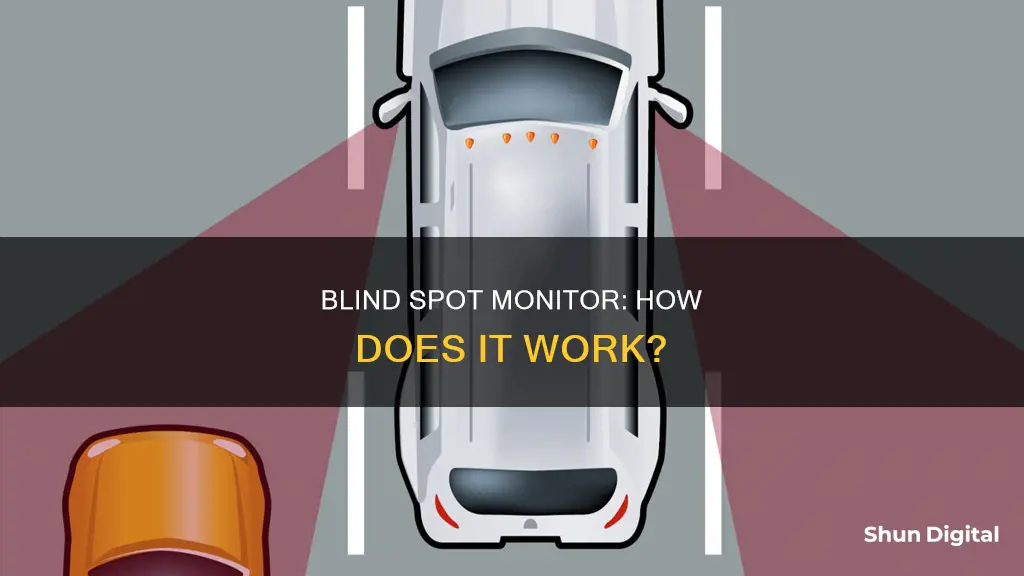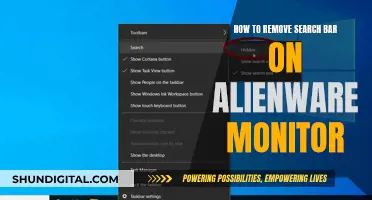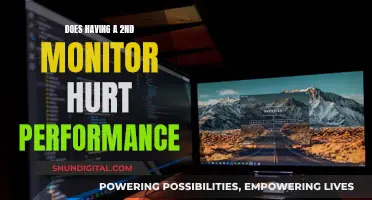
Blind spot monitors are an advanced driver assistance system (ADAS) designed to increase safety by alerting the driver to vehicles that may be in their blind spot. All vehicles have blind spots – areas on either side of a car that the driver cannot see when looking into the rearview or side-view mirrors. Blind spot monitors use sensors, cameras, radar, and/or ultrasonic sensors to detect vehicles in a car's blind spot, and then warn the driver with visual, audible, vibrating, or tactile alerts.
| Characteristics | Values |
|---|---|
| Purpose | Warns the driver of vehicles in their blind spot |
| Use | Recommended for larger vehicles, where blind spots are bigger |
| Benefits | Increases driving awareness, prevents crashes, increases response time |
| Types of alerts | Visual, audible, vibrating, tactile |
| Alert locations | Side-view mirror, head-up display, gauge cluster, steering wheel, seat, side pillar, inside the car |
| Alert types | Illuminated icon, flashing light, beeping tone, repeating chime, vibration |
| Other features | Rear Cross-Traffic Alert, lane-keeping assistance, automatic emergency steering |
What You'll Learn

How blind spot monitors work
Blind-spot monitoring (BSM) is a vehicle-based sensor device that detects other vehicles located in a car's blind spot—the areas or zones on either side of a car that a driver cannot see when looking into the rearview or side-view mirrors. All vehicles have blind spots, and BSM is designed to increase safety by alerting the driver to vehicles that may have escaped visibility in the side-view mirrors.
BSM uses radar or ultrasonic sensors located inside the left and right sides of the rear bumpers, as well as cameras in the side-view mirror housings, to detect vehicles within their monitored areas. These sensors detect a vehicle approaching the rear of your car in an adjacent lane. More advanced BSM systems also employ side-mounted cameras. When BSM recognises a vehicle about to enter a blind spot, it warns the driver that a particular lane is not clear.
The alert comes in the form of a visual indicator, such as an illuminated icon or flashing light in the side-view mirror, gauge cluster, or head-up display. This visual alert is often accompanied by an audible warning, such as a beeping tone or a repeating chime, or even a haptic alert such as vibration through the steering wheel or seat.
Some BSM systems also offer more advanced features, such as subtle autonomous steering or braking input to prevent the driver from changing lanes and colliding with another vehicle. These systems can nudge the driver away from the lane marker or steer them back to the centre of the lane.
Blind-spot monitoring is now commonly available in cars at every price point, although it was once only found in high-end luxury cars.
Connecting Pansonic SB Subwoofer to Studio Monitors: A Step-by-Step Guide
You may want to see also

Visual, audible, vibrating, or tactile warnings
Blind Spot Monitoring (BSM) systems are designed to increase safety by alerting the driver to vehicles that may not be visible in their side-view or rearview mirrors. BSM systems use a combination of radar or ultrasonic sensors and cameras to detect vehicles in a driver's blind spot. When a vehicle is detected, BSM systems will typically provide a visual, audible, vibrating, or tactile warning to the driver.
Visual warnings are one of the most common types of alerts used by BSM systems. These can include illuminated icons, flashing lights, or camera views displayed in the side-view mirror, gauge cluster, head-up display, or infotainment screen. Visual warnings are designed to be easily noticeable without being too distracting to the driver.
Audible alerts, such as beeping tones or repeating chimes, are often used in conjunction with visual warnings. These alerts can be especially useful when a driver is about to actively merge or change lanes, as they provide an additional layer of warning. Some BSM systems also offer customisable settings, allowing drivers to adjust the sensitivity and type of warning to their preference.
In addition to visual and audible warnings, some BSM systems provide haptic or tactile alerts, such as vibration through the steering wheel or seat. These types of warnings can be particularly effective in grabbing the driver's attention and indicating that it is unsafe to change lanes.
It is important to note that while BSM systems provide valuable assistance, they are not a substitute for proper mirror usage, cautious driving, and manually checking blind spots. Drivers should always remain vigilant and use BSM as an additional safety measure to reduce the risk of accidents.
Removing the Bezel from Your ASUS Monitor: A Step-by-Step Guide
You may want to see also

Blind spot monitoring systems on trucks
Blind spots are areas on either side of a car that the driver cannot see when looking into the rearview or side-view mirrors. All vehicles have blind spots, and they are why a driver should always turn their head and check for cars before changing lanes.
Blind-spot monitoring (BSM) is an advanced driving assistance system (ADAS) designed to alert the driver to vehicles that may have escaped visibility in the side-view mirrors. In simple terms, this technology helps prevent a driver from running into another vehicle moving in the same direction in an adjacent lane. BSM is not a substitute for checking mirrors and looking over one's shoulder, but it does offer an added safety measure to compensate for human error.
The blind-spot monitor is a vehicle-based sensor device that detects other vehicles located to the driver's side and rear. Warnings can be visual, audible, vibrating, or tactile. While BSM is primarily for highway use and highway speeds, it can be extremely useful for trucks, especially given the size trends of modern pickup trucks.
For the 2021 model year, 17 pickup trucks have blind-spot monitoring systems. These include full-size pickup trucks like the Chevrolet Silverado 1500, Chevrolet Silverado HD (2500-3500), Ford Super Duty (F-250-450), and GMC Sierra HD (2500-3500). Ford's Blind Spot Information System (BLIS) is an advanced blind-spot monitoring feature available on most vehicles in the Ford lineup. The system works like most blind-spot detectors, using radar modules embedded in the rear bumpers. These sensors trigger a warning on the dashboard when a car enters the blind-spot space.
The benefits of blind-spot monitoring systems for trucks are clear. They increase driving awareness, assist drivers of larger vehicles, prevent crashes, and increase response time. Aftermarket blind spot monitors are also available for older vehicles that may not be equipped with this technology.
Finding Monitor Constants for VGA Setup: A Comprehensive Guide
You may want to see also

Aftermarket blind spot monitors
There are a variety of aftermarket blind spot monitoring kits available, and many are universal, meaning they can be used regardless of the age, make, and model of your vehicle. These kits typically include sensors and indicators, and some also offer cameras that can be inserted into side mirrors.
The cost of aftermarket blind spot monitoring systems varies, with the most affordable systems priced under $250 and the most expensive systems costing $500 or more. The accuracy of these systems may be slightly lower than factory-installed technology, but they can still be a valuable addition to your vehicle.
If you choose to install an aftermarket blind spot monitor, you can opt for professional installation or attempt it yourself. Installation can be a complex process, and it is important to consult your owner's manual or a repair guide for specific instructions.
Overall, aftermarket blind spot monitors can be a beneficial investment, increasing your driving awareness and providing peace of mind for you and your passengers.
Monitoring CPU Usage: MSI Afterburner Guide
You may want to see also

Blind spot monitor brand names
Blind-spot monitoring (BSM) is an advanced driver-assistance system (ADAS) designed to increase safety by alerting the driver to vehicles that may be hidden in the side-view blind spots. BSM is not a substitute for checking mirrors and looking over one's shoulder but offers an added safety measure to compensate for human error.
Several car brands have incorporated BSM into their vehicles, often under a different name. Here are some examples:
- Volvo: Volvo developed the Blind Spot Information System (BLIS), which was first introduced on the 2001 Volvo SCC concept car and then placed into production on the 2003 Volvo XC90 SUV. BLIS has since been adapted by Ford for its Ford, Lincoln, and Mercury brands.
- Mazda: Mazda was the first Japanese automaker to offer BSM, which was initially introduced on the 2008 Mazda CX-9 Grand Touring. Mazda has since expanded the availability of BSM, adding it to the Mazda2, Mazda3, CX-3, CX-5, MX-5 Miata, and the CX-30.
- Ford: Ford uses the acronym BLIS for its blind spot detection system, which was first introduced in 2009 on the 2010 Ford Fusion and Fusion Hybrid, 2010 Mercury Milan and Milan Hybrid, and 2010 Lincoln MKZ.
- Mitsubishi: Mitsubishi offers a Blind Spot Warning (BSW) on the Pajero Sport, launched in 2016.
- Nissan: The Nissan Fuga/Infiniti M offered countersteering capabilities to keep the vehicle from colliding, introduced in 2010.
- Honda and Kia: Honda and Kia provide an audible alert in some models.
In addition to these brands, other car manufacturers such as Lincoln, Mercury, and Lincoln offer BSM systems, often with unique brand names or acronyms.
Aftermarket blind spot monitors are also available for older vehicles that may not be equipped with this technology. These can be purchased from retailers such as Amazon, Walmart, and Crutchfield, typically ranging in price from $300 to $500.
Uncover the True HDR10 Monitor Experience: What to Look For
You may want to see also
Frequently asked questions
A blind spot monitor is a vehicle-based sensor device that detects other vehicles located in a driver's blind spot, which are the areas on either side of a car that a driver cannot see when looking into the rearview or side-view mirrors.
Blind spot monitors increase driving awareness and response time, assist drivers of larger vehicles, and prevent crashes. They can also relieve stress and increase confidence for drivers and passengers.
Blind spot monitors use radar, ultrasonic sensors, sonar, or cameras to detect vehicles approaching the rear of a car in an adjoining lane. When a vehicle is detected, the driver is alerted through a visual, audible, vibrating, or tactile warning.







